The Importance of Visual Cues for Safe Evacuation
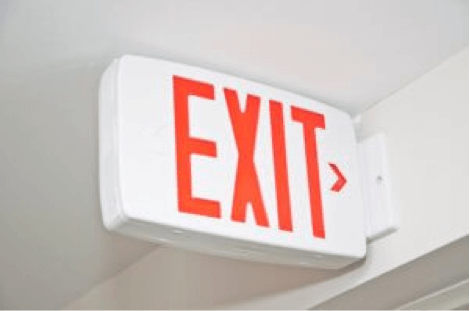
There’s a reason why exit signs are displayed in bright colors and in predictable locations. Whether the people inside a building are regular employees or first-time visitors, knowing how to safely exit a building is the most critical aspect of safe evacuation during a crisis.
Signs proscribing the use of elevators during an emergency are equally important, since power and mechanical failures are possible due to any number of causes. Having clear signage is critical because rational thinking and problem solving are often the first casualties when the threat of a natural disaster, terrorist attack, fire, or other emergency becomes imminent. Those well-placed signs save lives.
Under the Americans with Disabilities Act and OSHA safety guidelines, employers must provide accommodations to employees with disabilities, and provide accessibility in public buildings. In the cases of employees, clientele, or students who use wheelchairs, this includes providing access ramps; but it should also include a plan for safely evacuating a multi-story building when elevators are not in use. Whether you operate a hotel, shopping mall, arena, or office building–you need visual cues and signage to instruct your people in safe evacuation procedures for those who cannot use emergency stairways. Not only is this simply the right thing to do, it can also save you the expense of costly litigation should you ever experience a life-threatening emergency in your venue.
Does your building provide life-saving devices?
The simple fact is that many businesses’ plans for evacuating a wheelchair-bound individual is simply calling on emergency responders. Some may even have evacuation chairs somewhere in their facilities that allow non-ambulatory to be lowered down stairs. Thanks to the Slyde, however, there is a faster, safer, and more visible solution.
The Slyde is a medical sled that allows two to seven individuals to safely transport a disabled individual down multiple flights of stairs. It is lightweight, easy to operate, and, most importantly, can be publicly stored in an accessible area where it will be seen.
Look at the success of public-access defibrillators. It’s been determined that public-access defibrillators can double a person’s chance of surviving a cardiac arrest. Simply having defibrillators around in public spaces like malls and airports (accompanied by instructive signage) puts them on our radar and lets us know they are there for use in a medical emergency. They empower individuals to take active steps to help others. It is estimated that only 20 percent of heart attacks occur in public spaces, but among those, 95 percent of victims die before they reach a hospital.* Having defibrillators available improves their chances of survival.
The Slyde can also be viewed as a life-saving device. Should a fire or structural collapse put your constituents or clientele in danger, getting disabled individuals to safety can indeed save their lives. When elevators are not operating and everyone else is evacuating by stairs, you don’t want any individual to be left behind. Having a highly visible transport device at the ready can empower bystanders to take life-saving action.
Like defibrillators, the Slyde can be mounted easily in hallways and near staircases and elevators without obstructing traffic. A slim, mountable sleeve is available for purchase with the Slyde and can hold up to five devices more compactly than an evacuation chair. It also comes with a rope belay system that can be used to safely lower recumbent individuals down stairs. Add your own signage, train your staff, and you will have added another life-saving device to your evacuation plan.
Not only is the Slyde there for your people in an emergency, it also promotes public awareness of evacuation procedures. It is a powerful visual signal that you have a process and tools in place to evacuate disabled individuals.
To learn more about the Slyde, visit www.evacuationslyde.com or call us directly at 800-355-4628.
Healthcare Facilities: Realistic Evacuation Plans Require Multiple Types of Equipment
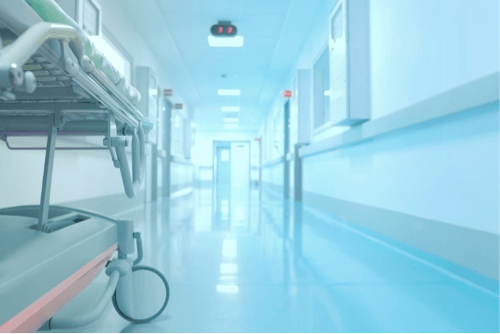
If you operate a hospital or medical facility, emergency evacuation preparedness is a high priority. How can you claim to provide high quality patient care if there are any gaps in your emergency evacuation plans? Can you guarantee that no patient or individual will be left behind? Planning for all scenarios takes time and resources, but it’s the only way to ensure patient safety, should a disaster befall your facility.
Whether that disaster comes as a natural weather event, man-made accident, or something more terrifying—such as a terrorist attack or active shooter scenario—your facility is responsible for making sure every patient is evacuated appropriately in a timely manner. Having the right equipment is a crucial step in making sure you are ready for potentialities.
The Role of Evacuation Equipment
When considering how realistic your evacuation plan may be, the most critical components are equipment and manpower. You must make sure you have the right equipment, in the right quantities, and in the right locations. You must also ensure you have adequate manpower to operate such equipment. These figures are going to vary wildly from one facility to another, so collecting location-specific data is necessary for your assessment team to manage and purchase equipment.
What kind of equipment does your facility need? Your equipment inventory will likely include a combination of the three main types of evacuation devices: carry devices, wheeled devices, and medical sleds.
- Carry devices, such as those used by firefighters, should only be reserved for use by highly trained staff, as asking staff to lift and carry patients in an emergency can lead to other problems (and more injury). Such a means of evacuation should not be relied upon for widespread use.
- Rolling equipment, such as evacuation chairs are a form of wheelchair that has been customized to be lowered down stairs. Elevators cannot be counted on to operate properly in an emergency, of course, so standard wheelchairs can only be considered evacuation devices on ground level floors.
- Medical evacuation sleds, such as the Slyde, can be used to pull (rather than lift) non-ambulatory patients down stairways and across hallways and obstacles.
When considering the benefits and limitations of these three types of device, it’s important to note that they all may play a role in the safe evacuation of your patients. For example, rolling devices may have an excellent staff/patient ratio, but they are not ideal for getting over any obstacles that may lie in your path. A medical sled is great for pulling a patient over obstacles, but requires two or more staff to operate it. An evacuation chair may be convenient, but may not be as accessible as a wall-mounted evacuation sled, depending on the situation. You simple cannot predict what an emergency situation may look like, so having a carefully calculated combination of options is your best bet.
Fill the Potential Gaps in Your Evacuation Plans
If your facility relies heavily on evacuation chairs or other rolling devices, consider the benefits of adding a greater number of medical sleds, such as the Slyde. They include easy-to-follow instructions and can accommodate patients and equipment up to a weight load of 500 (Slyde) or 800 lbs. (Bariatric Slyde). They can also be stored and made visible for use by visitors and untrained staff. If a disaster scenario resulted in staff members being injured or immobilized, it would certainly be a plus to have more devices around that could be operated by a wider range of individuals.
Having the right equipment is just one piece of the puzzle, but it helps to know what the puzzle may look like! Have your risk assessment team carry out a number of projections for predicted vulnerabilities, for both natural and man-made disasters. Only by envisioning all the potential situations your facility may face can you get to a point where you can estimate your needs.
Contact us at 800-355-4628 and we’ll be happy to answer any of your questions about our evacuation device.
K-12 Schools and Universities: Have You Planned for Safe Evacuation of Less Mobile Student and Staff?
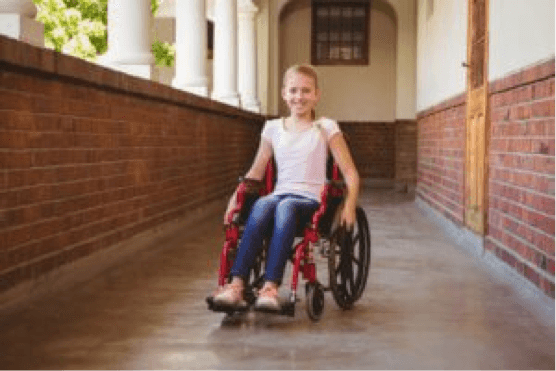
As a school or educational institution, you likely have ADA-compliant evacuation procedures set up to protect your less mobile population. You know that you cannot depend on elevators, first responders, or goodwill to transport your non-ambulatory students or staff members to safety. In addition to your pre-existing evacuation procedures, however, a medical evacuation device, such as the Slyde, can ensure your people have the tools and visual cues at hand to help make sure everyone is provided a method of evacuation.
A true crisis can take many forms, yet most schools do not prepare for more than a couple of potential scenarios. In the event of a power outage, violent attack, fire, natural disaster, structural damage, or other emergency situation, any number of obstacles can leave your evacuation plans wanting. By diversifying your options for transporting disabled or unconscious students, you offer more possible solutions and can cover a broader range of contingencies.
The Slyde (formerly called the Paraslyde) is a medical sled that can be operated by two to seven individuals to transport an immobilized person safely down flights of stairs. The Slyde is small, lightweight, and employs a series of web handles and straps to guide a recumbent individual down several flights of stairs. While students and staff who use wheelchairs are the most obvious beneficiaries of a Slyde evacuation device, you may be surprised by who else may have trouble getting down a stairway during an emergency.
Who Else Can Benefit from a Slyde?
In addition to any wheelchair-bound students you are already aware of, there are a number of conditions that may or may not be disclosed on a student or staff member’s official record. Many of these can impact safe and speedy evacuation and may still leave you liable should someone be left behind. For example, temporary conditions both visible (a student with a broken leg) and non-visible (a staff member recovering from a slipped disc or temporarily impaired vision) may leave a less-mobile individual with no way to exit a building. While your permanently disabled or wheelchair-bound students may be well known to you, there is always the possibility that someone may be temporarily using crutches, a cane, a walker, or have other mobility issues that may preclude safe descent of stairs.
Beyond physical limitations, there are other factors that may hinder a person’s ability to function normally during an emergency. Psychological or cognitive conditions, such as PTSD, panic disorders, or autism spectrum disorders easily have the potential to render a person unable to function as expected when a true crisis occurs. Having a device on hand that can safely evacuate any unconscious or nonmobile individuals can help you ensure you are prepared for many scenarios.
Protect Your Students and Staff; Protect Your School
Most schools are familiar with the requirements of the Americans with Disabilities Act, and understand its bearing on state-mandated emergency preparedness and evacuation planning. However, what they may not know is that there have been a series of lawsuits* in recent years in which schools that thought they were prepared were found to be inadequate. Their plans failed to accommodate their disabled students when it mattered. Such schools have had to pay costly settlements for their mistakes.
The most important step you can take to protect your students and staff is to establish an evacuation plan that covers as many potential scenarios as possible. Many schools establish crisis management plans that meet basic state requirements on paper, but leave gaps that leave less-mobile students vulnerable. Adding a Slyde to your facilities can help you make sure you have multiple options and multiple pathways for evacuating disabled or unconscious students.
How to Add the Slyde to Your Evacuation Plan
- Address your students and staff to inform them the device is available for anyone who may not be able to use stairs during an emergency or crisis.
- Keep evacuation Slydes mounted between hallways and stairwells or near elevators.
- Train staff in the safe use of evacuation devices.
- Post “If you need help…” and “How to use the Slyde…” signage at designated points, so anyone can request help and operate the device in a crisis.
- Conduct full contingency drills to rehearse your evacuation plan.
Your present emergency safety procedures may be strong already. But with diverse and constantly changing student populations, the Slyde can help give you reassurance that a safe evacuation (or drill) is always possible. To learn more about the Slyde, visit www.evacuationslyde.com or call us at 800-355-4628.
Fast Evacuation for Individuals of Limited Mobility
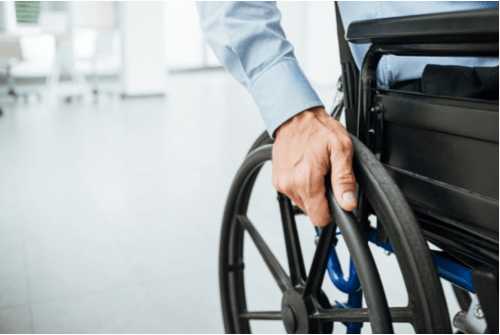
Does your evacuation plan include a fast, safe mode of transport for the wheelchair-bound, disabled, or other persons of limited mobility? Wheelchair ramps and elevators may get you through the day-to-day of accommodating all of your patients, students, employees, or clientele—but in an emergency, you can’t afford to leave anyone behind.
When planning for safe evacuation on non-ambulatory individuals, we may establish any number of plans that work on paper, but may not play out the way we imagine them. For example, relying on an evacuation chair may not work if a structural collapse creates rubble that blocks the pathway of the chair. Relying on first responders to remove a disabled individual is not a valid plan if an active shooter scenario prevents them from entering the building. A strong evacuation plan for disabled or non-ambulatory individuals should include multiple solutions to address a variety of contingencies. Rational thinking and shared responsibility are some of the earliest casualties of real emergencies, and the truth is that many evacuation “plans” for wheelchair-bound individuals simply fail.
For example, in 2014 Watchung Hills Regional High School* left a wheelchair-bound student on the second floor during a fire drill and quickly found itself subject to a lawsuit for violating the Americans with Disabilities Act (ADA). The New Jersey school’s original “plan” for evacuating their two disabled students was to only give them classes on the first floor. When reality played out differently, the school realized their plan was insufficient. They paid dearly for their mistake. Sadly, this is not the only time a disabled student was not evacuated properly, nor is it the first lawsuit a school has had to face.
Does Your Evacuation Plan Comply with the ADA?
Beyond schools and universities, practically every business or organization should be ready and prepared to assist a disabled or unconscious individual evacuate quickly in an emergency scenario. The reality is that lawsuits have been won over mere drills, so imagine what could happen in a legitimate crisis. Legal liability aside, you have a moral obligation to make sure all individuals—especially the most vulnerable—are part of your evacuation plan.
If you operate a hotel, resort, arena, office building or large business, it is your responsibility to ensure the safety of your people. Consider the implications of leaving a member of your team or clientele behind. Having the right tools and procedures established before a crisis occurs may help you save lives and avoid costly litigation.
The Slyde Solution
Rather than relying on the impromptu resourcefulness of colleagues or bystanders, there is a solution to this problem that can ensure a safe, easy stairway evacuation: the Slyde. This lightweight medical sled allows for fast escapes in any number of crisis scenarios or drills. The individual is secured by straps, so as few as two people can guide it down a stairway to safety. This means it can be used to transport more than just the wheelchair bound; it can also be used to move injured or unconscious individuals. The device is made of durable corrugated polypropylene, so it can accommodate up to 500 lbs., (or 800 lbs., for the Bariatric Slyde). Its four web handles allow operators to guide it easily down stairs and straps allow for it to be gently pulled forward over obstacles, if needed.
The Slyde can easily be mounted in a storage sleeve in convenient locations (such as near elevators and stairways), and accompanied by a rope belay system for safely lowering individuals down stairs. With a Slyde, you can be ready to evacuate your wheelchair-bound constituents with confidence.
The bottom line is that you can’t predict when a natural disaster, power outage, chemical spill, fire, violent attack or structural damage may affect your facility, but you can be ready to evacuate everyone safely when a crisis unfolds. The Slyde can help you rest easy knowing that you have a life-saving device at hand to ensure safe transport for any individuals with mobility issues.
The Slyde comes in two sizes and can be operated by two to seven people during an evacuation. It is thin and wall-mountable, so it will be there when you need it. To learn more about the Slyde, visit www.evacuationslyde.com or call us at 800-355-4628.
Avoid the Potential for Costly Litigation – Be Ready for Disabled Evacuation with the Slyde

If your business interacts with the public on a regular basis, you may already be serving disabled individuals adequately in the day-to-day. But have you thought about what would happen in the event of an emergency evacuation, active shooter situation, or other potential crisis or disaster? Do your evacuation plans have a resource for transporting non-ambulatory or disabled individuals through emergency exit routes?
You have a moral and legal obligation to safely evacuate your wheelchair-bound clientele, constituents, or students. If your emergency preparedness plan does not have a system in place for transporting wheelchair bound individuals down stairs, the Slyde may be a worthy investment for future safety of the people in your care—as well as a safeguard against future lawsuits.
The Americans with Disabilities Act
In America, we believe that everyone should have equal opportunities and equal access to services. It’s part of our fundamental beliefs that all of us should be treated equally and fairly, and our legislation has evolved to reflect this belief. The Americans with Disabilities Act (ADA), in particular, aims to even the playing field for disabled individuals and ensure they have equal access to civic life, be it in schools, transportation, housing, public services, or police and emergency response.
The ADA defines a person with a disability as someone who has a physical or mental impairment that substantially limits one or more major life activity. This can include a broad range of conditions, and can include individuals who outwardly appear disabled, such as those who use wheelchairs, to individuals of limited sight, hearing, or cognitive function. Businesses and organizations who do not provide the disabled with equal access to services can face costly lawsuits.
In 2014, A lawsuit was filed against New York’s New Rochelle School District1 when they failed to two evacuate two wheelchair bound students during a fire drill. The students were not harmed in any way, but by not evacuating the children along with the rest of the student population, they failed to provide the disabled students “with meaningful access to the school’s emergency preparedness programs.” In this case, it wasn’t about injury or harm, but access.
A similar lawsuit was filed against Watchung Regional High School of New Jersey2 when another student of limited mobility was left behind during a safety drill. Again, the school did not get the student out of the building and therefore found itself accused of violating the ADA.
These examples are both schools, so the nature of their relationship with the protected individuals is a bit different from those of retailers, employers, arenas, hotels, or other businesses. However, anyone can find themselves in hot water over ADA mandated accommodations. You want to be prepared, especially when you consider all the things that can go wrong during emergency scenarios, such as natural disasters, structural damage, chemical spills, fires, or any other potential threat.
How the Slyde Can Help Your Business Accommodate the Disabled
Due to potential mechanical and power failure, elevators are not recommended for use during evacuations and drills. So where does that leave your disabled people? There are several ways that disabled individuals can be safely evacuated from a multistory building, and having a safety device on hand can inspire confidence and show that you are ready and prepared to evacuate non-ambulatory persons during a crisis.
Evacuation chairs are commonly used by hospitals and medical facilities, but operators must be well-trained in order to control the safe descent of the chairs down stairwells. The transportee must also be able to control him or herself to stay safely upright and balanced in the chair.
A medical evacuation sled, such as the Slyde, may be a better option for your business. It can be safely used by two to seven individuals with little-to-no training to guide a recumbent person down stairs. In addition to evacuating wheelchair-bound individuals, it can also be used to get an unconscious or injured person to safety, since it includes straps that hold the person in place.
The Slyde, (formerly called the ParaSlyde) is lightweight and can be easily mounted flat against the wall at critical exit points, where it can be seen and acknowledged. Its easy visibility and versatility make the Slyde a better choice for peace of mind.
Learn more about the legal issues surrounding the Americans with Disabilities Act, or visit our website to learn more about the Slyde. Call our office at 800-355-4628 to learn more about the Slyde as a safety accommodation for your business.
Evacuation Chairs vs. Slyde Medical Sleds – Some Pros and Cons
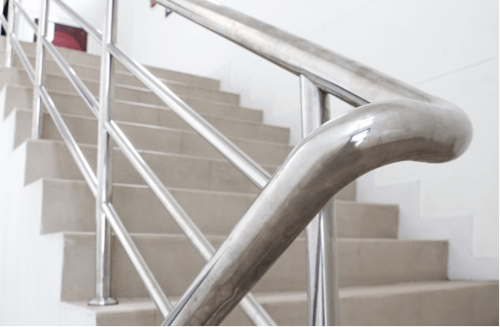
When considering all the possibilities for evacuating a disabled person down stairs, there are many circumstances to consider. In a true emergency there are several methods of getting a disabled or unconscious person to safety, including (1) the fireman’s lift (carrying the person over one’s shoulder), (2) an evacuation chair, and (3) a medical sled, such as the Slyde.
Each evacuation technique has unique benefits, but every disabled individual and every emergency situation may have specific factors to consider. Are the operators of the rescue method trained? Do they need to be? Is there time to wait for a first responder or trained rescuer? Will the person need to be strapped in? Will the disabled person’s weight (or the rescuer’s strength) be an issue?
Additionally, one must consider the setting of the evacuation. Evacuating a hotel or sports arena is a far different thing from evacuating a hospital or school. Population size, the known presence of disabled individuals, and the number emergency routes to be covered are all factors that may make one evacuation device more amenable than another.
Evacuation Chairs
Evacuation chairs are usually a standard resource for hospitals and medical facilities, as they allow one staff member to lower a disabled person safely down a staircase. This means they can accommodate more disabled individuals at once, as only one staff member and chair is needed per person.
However, an evacuation chair may not be adequate if the person being evacuated is unconscious, as it does not hold the patient in place. Furthermore, it takes a good bit of training and practice to use an evacuation chair correctly—which is fine for hospitals—but what about situations in which people with no prior training are the only resource on hand? Without proper training, an evacuation chair cannot be used if the patient is heavier than the chair operator.
Pros
- Provides fast evacuation device for conscious/cooperative individuals down stairs
- Convenient 1:1 ratio of user to transportee
Cons
- Operators must be trained and practiced in their use
- Cannot be used to transport unconscious or unwieldy patients
- Requires someone to bring the chair to the disabled individual (may need to be stored far from the stairs)
- Heavy
The Slyde Medical Sled
Medical sleds, such as the Slyde, are a take on the classic stretcher, modified to facilitate transport down stairways. The non-ambulatory individual is strapped in horizontally and guided down stairs using by two to seven operators. This means that any individual can be transported, even when unconscious or badly injured.
A benefit of the Slyde is that one can purchase a storage sleeve and rope belay system to accompany it, which make it more accessible and at-the-ready for use by bystanders. They are lightweight and slim, so they can be stored in a way that does not obstruct traffic. Several Slydes can be stored in each storage sleeve, so multiple devices may be made available at high traffic areas. A standard Slyde can hold a person of up to 500 lbs. and the Bariatric Slyde can accommodate a person of up to 800 lbs., with no prior training required of operators. Furthermore, unlike an evacuation chair, which must be lowered from above, a medical sled can be guided or pulled around obstacles.
Pros
- Can be used with less training than the chair
- May be easily stored near the point of use
- Can accommodate very heavy individuals
- Can accommodate unconscious individuals
- More affordable
- Lightweight
Cons
- Require 1:2-7 ratio of transportee to operators, depending on weight.
- Requires the use of rope belay system for larger individuals.
As an alternative to evacuation chairs, medical sleds offer some benefits to complement the chairs’ limitations. They also can be used a broader range of settings, since they require less training for operation.
If you want an evacuation device on hand for transporting disabled, injured, or unconscious individuals down emergency stairways, visit www.evacuatioslyde.com to learn more about the unique features of the Slyde.
Rescue Task Force Vs. Tactical Medics: Understanding the Role of an Emergency Medic
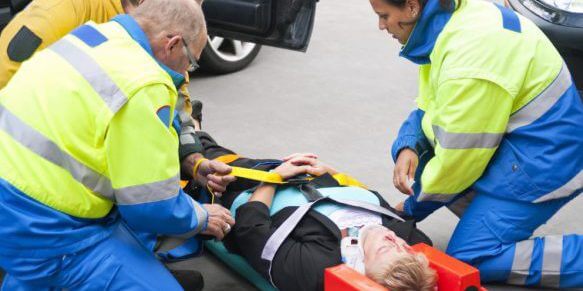
During an active shooter situation, the wounded have to be taken care of as quickly as possible. In the past, the custom for emergency medical personnel was to stand on the sidelines and wait until the police had completely secured the situation before rushing in and trying to save as many lives as possible. Nowadays, however, there are new types of emergency medics entering the scene. Tactical medics and rescue task forces are medics who are equipped with body armor and weapons, and have the ability to fire upon the shooters should they encounter them. (more…)
8 Things to Know When Entering a Mass Casualty Scene
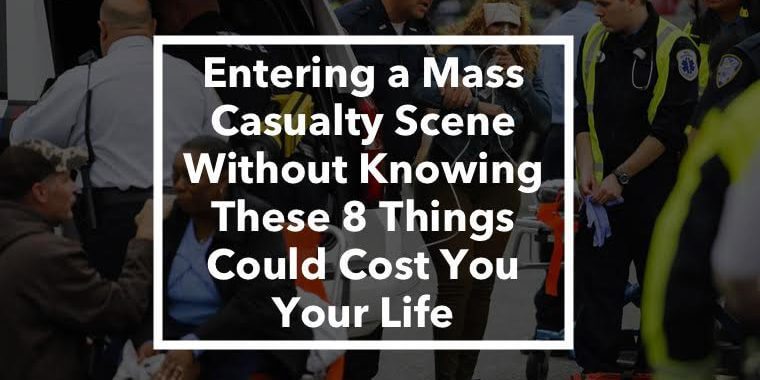
When a mass casualty event takes place, action needs to be taken immediately to ensure that it is contained and resolved as soon as humanly possible. Often the actions of the first arriving crew can set the tone for whether a mass casualty scene is handled correctly, or poorly. Competent handling of a mass casualty situation can bring it to an end as quick as possible, which is the goal of everyone involved. Medical teams need to have an understanding of how to assess the scene initially and provide triage and transport to the wounded. To ensure this process goes as smoothly as possible, there are eight things for EMS teams to keep in mind and follow when arriving on a mass casualty incident. (more…)
These Tips for Planning an Active Shooter Drill Could Mean the Difference Between Life and Death
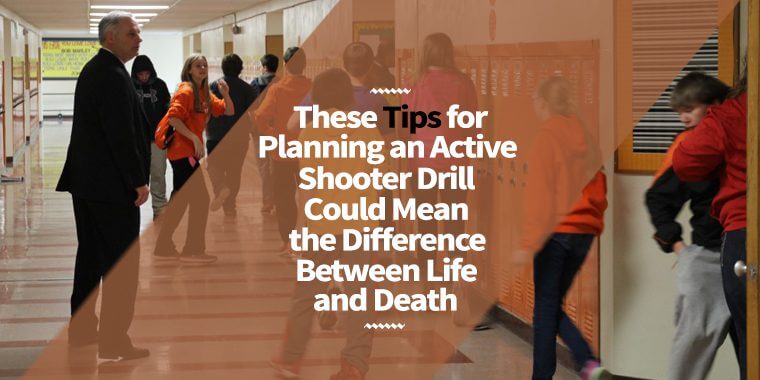
With the number of active shooter incidents increasingly each year, having an active shooter drill is crucial for any company. When it comes to planning an active shooter drill, there is a particular process that should be followed to ensure the smooth planning of an active shooter drill. The five steps to planning an active shooter drill are as follows: (more…)
Most People Forget These 3 Crucial Aspects After a Mass Shooting
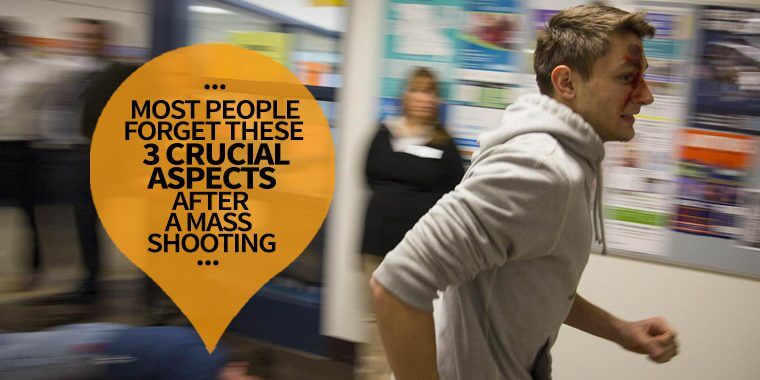
Active shooter situations are incredibly traumatizing. Employees caught in such a situation often come out the other side feeling numb or devastated with grief. Understanding what to expect in the moments directly after an active shooter situation can prepare people to better deal with it if the time ever comes. Here are three crucial aspects that people should understand and be prepared for if they ever have to experience an active shooter scenario. (more…)
